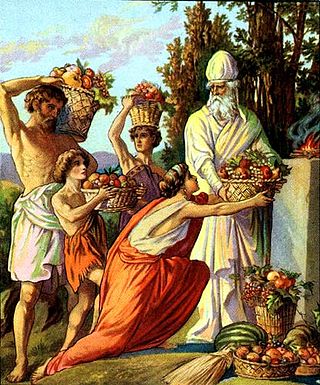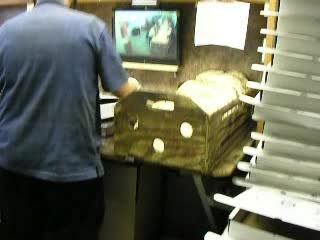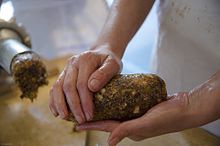
The Mishnah or the Mishna is the first written collection of the Jewish oral traditions that are known as the Oral Torah. It is also the first work of rabbinic literature, with the oldest surviving material dating to the 6th to 7th centuries CE.

Rabbinic literature, in its broadest sense, is the entire corpus of works authored by rabbis throughout Jewish history. The term typically refers to literature from the Talmudic era, as opposed to medieval and modern rabbinic writings. It aligns with the Hebrew term Sifrut Chazal, which translates to “literature [of our] sages” and generally pertains only to the sages (Chazal) from the Talmudic period. This more specific sense of "Rabbinic literature"—referring to the Talmud, Midrashim, and related writings, but hardly ever to later texts—is how the term is generally intended when used in contemporary academic writing. The terms mefareshim and parshanim almost always refer to later, post-Talmudic writers of rabbinic glosses on Biblical and Talmudic texts.

Obadiah ben Abraham of Bertinoro, commonly known as "The Bartenura", was a 15th-century Italian rabbi best known for his popular commentary on the Mishnah. In his later years, he rejuvenated the Jewish community of Jerusalem and became recognised as the spiritual leader of the Jews of his generation.

Maror are the bitter herbs eaten at the Passover Seder in keeping with the biblical commandment "with bitter herbs they shall eat it.". The Maror is one of the symbolic foods placed on the Passover Seder plate.

Kil'ayim is the fourth tractate of Seder Zeraim of the Mishnah, dealing with several biblical prohibitions of mixed species, namely, planting certain mixtures of seeds, grafting different species of trees together, growing plants other than grapevines in vineyards, crossbreeding animals, working a team of different kinds of animals together, and mixing wool and linen in garments.

Ki Tavo, Ki Thavo, Ki Tabo, Ki Thabo, or Ki Savo is the 50th weekly Torah portion in the annual Jewish cycle of Torah reading and the seventh in the Book of Deuteronomy. It comprises Deuteronomy 26:1–29:8. The parashah tells of the ceremony of the first fruits, tithes, and the blessings from observance and curses from violation of the law.

The tithe is specifically mentioned in the Books of Leviticus, Numbers and Deuteronomy. The tithe system was organized in a seven-year cycle, the seventh-year corresponding to the Shemittah-cycle in which year tithes were broken-off, and in every third and sixth-year of this cycle the second tithe replaced with the poor man's tithe. These tithes were akin to taxes for the people of Israel and were mandatory, not optional giving. This tithe was distributed locally "within thy gates" to support the Levites and assist the poor. Every year, Bikkurim, terumah, ma'aser rishon and terumat ma'aser were separated from the grain, wine and oil. Initially, the commandment to separate tithes from one's produce only applied when the entire nation of Israel had settled in the Land of Israel. The Returnees from the Babylonian exile who had resettled the country were a Jewish minority, and who, although they were not obligated to tithe their produce, put themselves under a voluntary bind to do so, and which practice became obligatory upon all.
The House of Hillel and House of Shammai were, among Jewish scholars, two schools of thought during the period of tannaim, named after the sages Hillel and Shammai who founded them. These two schools had vigorous debates on matters of ritual practice, ethics, and theology which were critical for the shaping of the Oral Law and Judaism as it is today.

A tabun oven, or simply tabun, is a portable clay oven, shaped like a truncated cone. While all were made with a top opening, which could be used as a small stove top, some were made with an opening at the bottom from which to stoke the fire. Built and used even before biblical times as the family, neighbourhood, or village oven, tabun ovens continue to be built and used in parts of the Middle East today.
Kil'ayim are the prohibitions in Jewish law which proscribe the planting of certain mixtures of seeds, grafting, the mixing of plants in vineyards, the crossbreeding of animals, the formation of a team in which different kinds of animals work together, and the mixing of wool with linen in garments.

In Judaism, the dough offering is an assertive command requiring the owner of bread dough to give a part of the kneaded dough to a kohen. The obligation to separate the dough offering from the dough begins the moment the dough is kneaded, but may also be separated after the loaves are baked. This commandment is one of the twenty-four kohanic gifts, and, by a biblical injunction, is only obligatory in the Land of Israel, but from a rabbinic injunction applies also to breadstuffs made outside the Land of Israel.

Demai is a Halakhic term meaning "doubtful". The demai status applies to agricultural produce acquired from common people who are suspected of not correctly separating tithes according to Jewish law. As a result, one who acquires demai produce must separate some of the tithes himself, in case this was not done earlier.
The incense offering, a blend of aromatic substances that exhale perfume during combustion, usually consisting of spices and gums burnt as an act of worship, occupied a prominent position in the sacrificial legislation of the ancient Hebrews.

The Mosaic of Reḥob, is a late 3rd–6th century CE mosaic discovered in 1973. The mosaic, written in late Mishnaic Hebrew, describes the geography and agricultural rules of the local Jews of the era. It was inlaid in the floor of the foyer or narthex of an ancient synagogue near Tel Rehov, 4.5 kilometres (2.8 mi) south of Beit She'an and about 6.5 kilometres (4.0 mi) west of the Jordan River. The mosaic contains the longest written text yet discovered in any Hebrew mosaic in Israel, and also the oldest known Talmudic text.

Nathan ben Abraham, known also by the epithet President of the Academy in the Land of Israel, was an 11th-century rabbi and exegete of the Mishnah who lived in Ramla, in the Jund Filastin district of the Fatimid Caliphate. He was the author of the first known commentary covering the entire Mishnah.
Sicaricon, lit. 'usurping occupant; possessor of confiscated property; the law concerning the purchase of confiscated property', refers in Jewish law to a former act and counter-measure meant to deal effectively with religious persecution against Jews in which the Roman government had permitted its own citizens to seize the property of Jewish landowners who were either absent or killed in war, or taken captive, or else where Roman citizens had received property that had been confiscated by the state in the laws prescribed under ager publicus, and to which the original Jewish owners of such property had not incurred any legal debt or fine, but had simply been the victims of war and the illegal, governmental expropriation of such lands from their rightful owners or heirs. The original Jewish law, made at some time after the First Jewish-Roman War with Vespasian and his son Titus, saw additional amendments by later rabbinic courts, all of which were meant to safe-guard against depriving the original landowners and their heirs of any land that belonged to them, and to ensure their ability to redeem such property in the future.

Bikkurim, or first-fruits, are a type of sacrificial offering which was offered by ancient Israelites. In each agricultural season, the first-grown fruits were brought to the Temple and laid by the altar, and a special declaration recited.

Isaac ben Melchizedek, was a rabbinic scholar from Siponto, Italy, and one of the first medieval scholars to have composed a commentary on the Mishnah, of which only his commentary on Seder Zera'im survives. Elements of the Mishnaic order of Taharot are also cited in his name by the Tosafists, but the complete work is no longer extant.

The primitive clay oven, or earthen oven / cob oven, has been used since ancient times by diverse cultures and societies, primarily for, but not exclusive to, baking before the invention of cast-iron stoves, and gas and electric ovens. The general build and shape of clay ovens were, mostly, common to all peoples, with only slight variations in size and in materials used to construct the oven. In primitive courtyards and farmhouses, earthen ovens were built on the ground.

Ash cake is a type of bread baked over a layer of heated stones or sand and covered-over in hot ashes, a practice still found principally in Arabian countries, especially among Bedouins.















